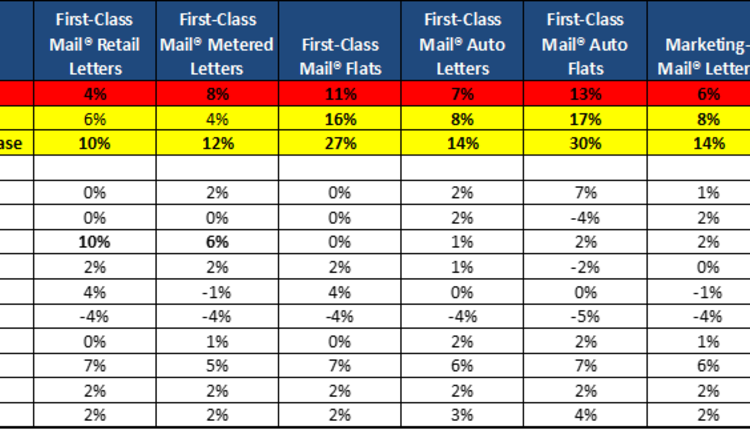If you are looking for the easiest way to save money on postage, look no further. Presort Services will pick up your mail daily, weekly, or as needed, and commingle it with other clients on their sorting systems to get you lower postage rates. They will make sure your mail meets all postal regulations and there is no work involved except scheduling the pickups. These services will save you six to 39% based on your volumes, densities, weights, and types of mail submitted.

In this article, we will go through the details of how these services work and what items you need to consider, making sure it is the right fit for your company. As I always state, I have no affiliation with any presort service, but prior to starting Postal Advocate, did run the largest presort program that had over 4,000 users.
How do these services work? These providers have one or several sorters that are similar to what the USPS uses in its facilities. These sorters read the address on the mailpiece and spray the barcode on the bottom right. They can then sort the mail into bins to where it is going throughout the country. Presort providers work on a revenue split arrangement with the customer and the USPS. Here is the most common:
· First-Class Mail Single Piece Postage Rate $.46
· Rate the customer meters the mail $.433 ($.027 savings)
The presort service sorts the mail as deep as they can get it. Hopefully, most will be to the highest sort levels the USPS offers (3 and 5-Digit) at rates at $.36-.384 (see chart below) and the USPS pays them the difference in a Value Added Rebate (VAR). This payment by the USPS covers their transportation, operations, and hopefully leaves room for them to make a profit.
Higher volume mailers can typically get a larger percentage of the savings as shown on the chart below. Items that determine your rate are volumes, frequency, ZIP Code densities, machine read rates for your mail (typically determined from a test), and how competitive your local market is with other presort providers.

What Mail Qualifies?

In this article, we will go through the details of how these services work and what items you need to consider, making sure it is the right fit for your company. As I always state, I have no affiliation with any presort service, but prior to starting Postal Advocate, did run the largest presort program that had over 4,000 users.
How do these services work? These providers have one or several sorters that are similar to what the USPS uses in its facilities. These sorters read the address on the mailpiece and spray the barcode on the bottom right. They can then sort the mail into bins to where it is going throughout the country. Presort providers work on a revenue split arrangement with the customer and the USPS. Here is the most common:
· First-Class Mail Single Piece Postage Rate $.46
· Rate the customer meters the mail $.433 ($.027 savings)
The presort service sorts the mail as deep as they can get it. Hopefully, most will be to the highest sort levels the USPS offers (3 and 5-Digit) at rates at $.36-.384 (see chart below) and the USPS pays them the difference in a Value Added Rebate (VAR). This payment by the USPS covers their transportation, operations, and hopefully leaves room for them to make a profit.
Higher volume mailers can typically get a larger percentage of the savings as shown on the chart below. Items that determine your rate are volumes, frequency, ZIP Code densities, machine read rates for your mail (typically determined from a test), and how competitive your local market is with other presort providers.

What Mail Qualifies?
· First-Class Mail Letters: Most presort services are looking for non-handwritten letter mail up to the maximum weight of 3.5 ounces. There are services that will pick up as little as 400 pieces per day or single pickups of 1,000 pieces or more. Last year the USPS came out with a program called "Second Ounce Rides Free" to get people to add more content to their mail. This savings only applies at the discounted rates listed on the chart above and creates extra incentive to use a presort service.
· First-Class Mail Flats: Many presort services will have flat sorting machines and can process non-handwritten pieces as large as seven to 12 ounces. The client savings and presort service profit is much greater for flats and typically they can have lower thresholds for pickup. It is best to combine your letter and flat volumes when negotiating rates and determining eligibility. It is important to note that the USPS does not offer a Value Added Rebate (VAR) for flats like they do for letters. This means is that you will need to meter your mail at the lower rates (3 and 5-digit) and the presort service will send you an invoice for the difference of your negotiated rate minus the metered price.
· Standard Mail: This is the fastest growth area in this space because Standard Mail volumes are remaining constant while First-Class Mail is declining. The model is different because the rate is not based on the sort levels, but on destination entry discounts earned by moving mail closer to its final destination. Most Standard Mail given to presort services will already be barcoded and trayed by the client. All the presort service is doing is getting it to the right Destination Network Distribution Center (DNDC) or Destination Sectional Center Facility (DSCF) where the mail is going. In exchange, the USPS offers additional discounts shown below that the presort service will share in for doing the work.

How to select the right service provider In many markets, you may not have a choice because there is only one presort provider covering your area. In these situations, you still want to look at their reputation in the marketplace and potentially take a tour of their facility to make sure your mail is going to be handled in a secure manner. If you are lucky enough to have a choice of vendors, here are the items you want to consider:
· Rate/Savings: What savings level are they offering and do they charge fees for any of the following:
o Transportation
o Items that cannot be read on their machines.
o Address corrections and running mail through FASTForward.
o Other miscellaneous charges.
· MPTQM Certifications: The best run presort services will have this level of certification that shows they meet the highest standards in processing and security.
· First-Class Mail Flats: Many presort services will have flat sorting machines and can process non-handwritten pieces as large as seven to 12 ounces. The client savings and presort service profit is much greater for flats and typically they can have lower thresholds for pickup. It is best to combine your letter and flat volumes when negotiating rates and determining eligibility. It is important to note that the USPS does not offer a Value Added Rebate (VAR) for flats like they do for letters. This means is that you will need to meter your mail at the lower rates (3 and 5-digit) and the presort service will send you an invoice for the difference of your negotiated rate minus the metered price.
· Standard Mail: This is the fastest growth area in this space because Standard Mail volumes are remaining constant while First-Class Mail is declining. The model is different because the rate is not based on the sort levels, but on destination entry discounts earned by moving mail closer to its final destination. Most Standard Mail given to presort services will already be barcoded and trayed by the client. All the presort service is doing is getting it to the right Destination Network Distribution Center (DNDC) or Destination Sectional Center Facility (DSCF) where the mail is going. In exchange, the USPS offers additional discounts shown below that the presort service will share in for doing the work.

How to select the right service provider In many markets, you may not have a choice because there is only one presort provider covering your area. In these situations, you still want to look at their reputation in the marketplace and potentially take a tour of their facility to make sure your mail is going to be handled in a secure manner. If you are lucky enough to have a choice of vendors, here are the items you want to consider:
· Rate/Savings: What savings level are they offering and do they charge fees for any of the following:
o Transportation
o Items that cannot be read on their machines.
o Address corrections and running mail through FASTForward.
o Other miscellaneous charges.
· MPTQM Certifications: The best run presort services will have this level of certification that shows they meet the highest standards in processing and security.
· Security Procedures: Since they will be handling your mail, you need to make sure it is processed in a secure environment. As an example, this mail may have financial and medical information that could be harmful if exposed. Look at their internal processes, security cameras and if they have had issues in the past.
· What types of mail can they process? Letters, flats, standard, international?
· What other services do they provide? Metering, fulfillment, etc.
I do not have the exact numbers, but I am going to guess that there are about 100-150 independent presort services throughout the US. Most of these will have one to three sites located in a specific geographic area. Pitney Bowes also created the largest presort network in the US with its acquisition on PSI. They have 35 facilities and process over 14 billion pieces each year. Because of their footprint, they can move mail between facilities easily that can speed delivery, as well as pick up mail in areas where they do not have a site, furthering their reach.
I do not have the exact numbers, but I am going to guess that there are about 100-150 independent presort services throughout the US. Most of these will have one to three sites located in a specific geographic area. Pitney Bowes also created the largest presort network in the US with its acquisition on PSI. They have 35 facilities and process over 14 billion pieces each year. Because of their footprint, they can move mail between facilities easily that can speed delivery, as well as pick up mail in areas where they do not have a site, furthering their reach.
What else do I need to know? There are specific items you need to understand before committing to a service.
· Pickup Time: What time can they pick up your mail? Most companies want to schedule for 4-5:00 pm because that is when the mail is complete. Can they accommodate this schedule or will it need to be earlier based on when their truck is in your area?
· Day Delay: Most presort services will require that you date the mail for the next day because they are going to process it that evening and deposit it into the mail in the morning. Mail moving out of the area can make up some of this time based on it being barcoded and sorted but this does delay local mail. This is going to become less of an issue as the USPS moves to slow mail from one to three, to two to three day delivery in their network consolidation plan.
· Billing Charges: As we discussed above, know exactly what you are paying for. I have seen presort invoices where when the fees were added back in, were more expensive than single piece rates. Low to mid volume customers may do best with a no bill program on their letter mail.
· Address Quality Issues: Can the presort provider give you any data on mail that gets changed through their FASTForward system so you can clean up your addresses for the future?
· Consider Barcoding Yourself: If you do consistent mailings, you may want to barcode these in-house and not have to share the savings. Look at the cost of staff, software, hardware and transportation to make the right decision.
Conclusion Presort Services are the best and easiest way to reduce postage costs because they do all of the work and you save six to 39% on your mail. Hopefully this article gave you a framework to look at these providers to see if they are a fit for your operation.
Adam Lewenberg, CMDSS, MDC, is President of Postal Advocate Inc. and runs the largest Mail Audit and Recover firm in the United States. Their mission is to help entities with large numbers of locations reduce mail related expenses, recover lost postage funds, and simplify visibility and oversight. He can be reached at 617.372.6853 or adam.lewenberg@postaladvocate.com.
Adam Lewenberg, CMDSS, MDC, is President of Postal Advocate Inc. and runs the largest Mail Audit and Recover firm in the United States. Their mission is to help entities with large numbers of locations reduce mail related expenses, recover lost postage funds, and simplify visibility and oversight. He can be reached at 617.372.6853 or adam.lewenberg@postaladvocate.com.






![GettyImages-1170541989-[Converted]](https://cms-static.wehaacdn.com/mailingsystemstechnology-com/images/GettyImages-1170541989--Converted-.1803.widea.0.jpg)




